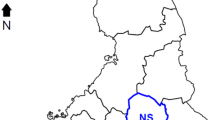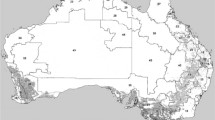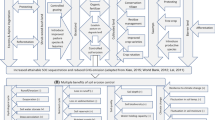Abstract
Purpose
Soil organic carbon (SOC) plays a key role in soil functioning and in greenhouse gas exchange with the atmosphere. Land use and land use changes can critically affect SOC. However, despite various methodological developments, there is still no scientific consensus on the best method to assess the holistic impact of land use and land use change within LCA. The SOCLE project aimed to review how SOC contribution to climate change is accounted for in LCA and to test the feasibility and sensitivity of best methodological options.
Methods
In total, five crop products (annual/perennial, temperate/tropical) and two livestock products were investigated through 22 scenarios of land use changes (LUC) and agricultural land management changes (LMC). Three methods were applied: IPCC Tier 1-2 (2006), Müller-Wenk and Brandaõ (2010) and Levasseur et al. (2012). We also carried out a sensitivity analysis on key variables, notably carbon stocks, reference states, and regeneration times.
Results and discussion
The accounting for LUC and LMC influenced greatly the results on the climate change impact. Compared to the impact of other GHG emissions, (i) LUC impacts ranged from − 23 to + 1702% with the IPCC method and from − 5 to + 336% with the Müller-Wenk and Brandaõ method, and (ii) LMC impacts from − 130 to + 54% and from − 31 to + 11%, respectively. The sensitivity analyses stressed the critical influence of all methodological and data choices on final results.
Conclusions
Based on the project results, we recommend accounting systematically for the impact of LULUC on climate change by applying, a minima, the comprehensive IPCC Tier 1 approach (2006), which provides default factors for SOC accounting. Where available, case-specific data should be used (e.g., Tier 2) for SOC stocks but also C:N ratio in order to model the degressive impact over 90% of the time period needed to reach equilibrium.





Similar content being viewed by others
Notes
ADEME is the French Environment and Energy Management Agency
UNEP is the United Nations Environment Programme now known as UN Environment
SETAC is the Society of Environmental Toxicology and Chemistry
References
Adhikari K, Hartemink AE (2016) Linking soils to ecosystem services — a global review. Geoderma 262:101–111
Baker JM, Ochsner TE, Venterea RT, Griffis TJ (2007) Tillage and soil carbon sequestration—what do we really know? Agric Ecosyst Environ 118(1):1–5
Beloin-Saint-Pierre D, Levasseur A, Margni M, Blanc I (2017) Implementing a dynamic life cycle assessment methodology with a case study on domestic hot water production. J Ind Ecol 21(5):1128–1138
Benoist A, Bessou C (2018) Soil organic carbon, climate change, and soil quality: a mapping of existing methods for LCA. http://agritrop.cirad.fr/582031/Detailed project report in French: https://www.ademe.fr/sites/default/files/assets/documents/rapport_de_revue_methodo_socle_final_2018.pdf (accessed 19 Sept 2019)
Benoist A, Cornillier C (2016) Towards a consensual method to assess climate change impacts from bio-based systems. http://agritrop.cirad.fr/580572/ (accessed 28 February 2019)
Bessou C, Chase LDC, Henson IE, Abdul-Manan AFN, Milà i Canals L et al (2014) Pilot application of PalmGHG, the roundtable on sustainable palm oil greenhouse gas calculator for oil palm products. J Clean Prod 73:136–145
Bos U, Horn R, Beck T (2016) LANCA - characterization factors for life cycle impact assessment - Version 2.0. Stuttgart, Germany
Brandani CB, Abbruzzini TF, Williams S, Easter M, Pellegrino Cerri CE, Paustian K (2015) Simulation of management and soil interactions impacting SOC dynamics in sugarcane using the CENTURY Model. GCB Bioenergy 7:646–657
Bright RM, Cherubini F, Strømman AH (2012) Climate impacts of bioenergy: inclusion of carbon cycle and albedo dynamics in life cycle impact assessment. Environ Impact Assess Rev 37:2–11
BSI (2011) PAS2050: specification for the assessment of the life cycle greenhouse gas emissions of goods and services by The British Standards Institution. 45 pp
Cao V, Margni M, Favis BD, Deschênes L (2017) Choice of land reference situation in life cycle impact assessment. Int J Life Cycle Assess 22:1220–1231
Corbeels M, Marchão RL, Neto MS, Ferreira EG, Madari BE et al (2016) Evidence of limited carbon sequestration in soils under no-tillage systems in the Cerrado of Brazil. Sci Rep 6:21450
Cowie AL, Orr BJ, Castillo Sanchez VM, Chasek P, Crossman ND et al (2018) Land in balance: the scientific conceptual framework for land degradation neutrality. Environ Sci Pol 79:25–35
Crowther TW, Todd-Brown KEO, Rowe CW, Wieder WR, Carey JC, Machmuller MB, Snoek BL, Fang S, Zhou G, Allison SD, Blair JM, Bridgham SD, Burton AJ, Carrillo Y, Reich PB, Clark JS, Classen AT, Dijkstra FA, Elberling B, Emmett BA, Estiarte M, Frey SD, Guo J, Harte J, Jiang L, Johnson BR, Kröel-Dulay G, Larsen KS, Laudon H, Lavallee JM, Luo Y, Lupascu M, Ma LN, Marhan S, Michelsen A, Mohan J, Niu S, Pendall E, Peñuelas J, Pfeifer-Meister L, Poll C, Reinsch S, Reynolds LL, Schmidt IK, Sistla S, Sokol NW, Templer PH, Treseder KK, Welker JM, Bradford MA (2016) Quantifying global soil carbon losses in response to warming. Nature 540(7631):104–108
de Vries W (2018) Soil carbon 4 per mille: a good initiative but let’s manage not only the soil but also the expectations: comment on Minasny et al. (2017). Geoderma 292:59–86
Dijkman TJ, Basset-Mens C, Antón A, Núñez M (2018) LCA of food and agriculture. In: Hauschild MZ, Rosenbaum RK, Olsen SI (eds) Life cycle assessment: theory and practice. Springer International Publishing, Cham, pp 723–754
Dominati E, Patterson M, Mackay A (2010) A framework for classifying and quantifying the natural capital and ecosystem services of soils. Ecol Econ 69(9):1858–1868
Duparque A, Dinh JL, Mary B (2013) AMG: a simple SOC balance model used in France for decision support. International workshop SOMpatic Rauischholtzhausern (Germany), November 20-22, 2013
Flynn HC, LM I Canals, Keller E, King H, Sim S et al (2012) Quantifying global greenhouse gas emissions from land-use change for crop production. Glob Chang Biol 18(5):1622–1635
Frank S, Havlík P, Soussana J-F, Levesque A, Valin H et al (2017) Reducing greenhouse gas emissions in agriculture without compromising food security? Environ Res Lett 12(10):105004. https://doi.org/10.1088/1748-9326/aa8c83
Fujisaki K (2014) Devenir des stocks de carbone organique des sols après déforestation et mise en culture : une analyse diachronique en contexte amazonien. Centre International d’Etudes Supérieures en Sciences Agronomiques (Montpellier SupAgro)
Garrigues E, Corson MS, Angers DA, van der Werf HMG, Walter C (2012) Soil quality in life cycle assessment: towards development of an indicator. Ecol Indic 18(0):434–442
Goglio P, Smith WN, Grant BB et al (2015) Accounting for soil carbon changes in agricultural life cycle assessment (LCA): A review. J Clen Prod 104:1–17
International Reference Life Cycle Data System (ILCD) (2011) Handbook—recommendations for life cycle impact assessment in the European context. First edition November 2011. EUR 24571 EN. Luxemburg Publications Office of the European Union. 159p
IPBES (2018) Summary for policymakers of the assessment report on land degradation and restoration of the Intergovernmental Science-Policy Platform on Biodiversity and Ecosystem Services. IPBES secretariat, Bonn
IPCC (2006) Guidelines for national greenhouse gas inventories. Vol 4 Agriculture, Forestry and Other Land Use. WMO/UNEP. http://www.ipcc-nggip.iges.or.jp/public/2006gl/index.html
IPCC (2007) Fourth Assessment Report. Climate change 2007 - synthesis report. WMO/UNEP. http://www.ipcc.ch/ipccreports/ar4-syr.htm
Karlen DL, Mausbach MJ, Doran JW, Cline RG, Harris RF, Schuman GE (1997) Soil quality: a concept, definition, and framework for evaluation. Soil Sci Soc Am J 61(1):4–10
Khatri P, Jain S (2017) Environmental life cycle assessment of edible oils: a review of current knowledge and future research challenges. J Clean Prod 152:63–76
Koellner T, de Baan L, Beck T, Brandão M, Civit B et al (2013) UNEP-SETAC guideline on global land use impact assessment on biodiversity and ecosystem services in LCA. Int J Life Cycle Assess 18(6):1188–1202
Koponen K, Soimakallio S, Kline KL, Cowie A, Brandão M (2018) Quantifying the climate effects of bioenergy – choice of reference system. Renew Sust Energ Rev 81:2271–2280
Lal R (2004) Soil carbon sequestration impacts on global climate change and food security. Science 304(5677):1623–1627
Lal R (2010) Managing soils and ecosystems for mitigating anthropogenic carbon emissions and advancing global food security. BioScience 60(9):708–721
Levasseur A, Lesage P, Margni M, Brandão M, Samson S (2012) Assessing temporary carbon sequestration and storage projects through land use, land-use change and forestry: comparison of dynamic life cycle assessment with ton-year approaches. Climate Change 115(3–4):759–776
Milà i Canals LM, Bauer C, Depestele J, Dubreuil A, Knuchel RF et al (2007a) Key elements in a framework for land use impact assessment within LCA. Int J Life Cycle Assess 12(1):5–15
Milà i Canals L, Romanyà J, Cowell SJ (2007b) Method for assessing impacts on life support functions (LSF) related to the use of “fertile land” in life cycle assessment (LCA). J Clean Prod 15(15):1426–1440
Minasny B, Malone BP, McBratney AB, Angers DA, Arrouays D et al (2017) Soil carbon 4 per mille. Geoderma 292:59–86
Montanarella L, Pennock DJ, McKenzie N, Badraoui M, Chude V et al (2016) World’s soils are under threat. Soil 2(1):79–82
Müller-Wenk R, Brandão M (2010) Climatic impact of land use in LCA—carbon transfers between vegetation/soil and air. Int J Life Cycle Assess 15(2):172–182
Muñoz I, Campra P, Fernández-Alba AR (2010) Including CO2-emission equivalence of changes in land surface albedo in life cycle assessment. Methodology and case study on greenhouse agriculture. Int J Life Cycle Assess 15:672–681
Notarnicola B, Sala S, Anton A, McLaren SJ, Saouter E et al (2017) The role of life cycle assessment in supporting sustainable agri-food systems: a review of the challenges. J Clean Prod 140:399–409
Novaes RML, Pazianotto RAAA, Brandão M, Alves BJR, May A et al (2017) Estimating 20-year land-use change and derived CO2 emissions associated with crops, pasture and forestry in Brazil and each of its 27 states. Glob Chang Biol 23(9):3716–3728
Núñez M, Antón A, Muñoz P, Rieradevall J (2013) Inclusion of soil erosion impacts in life cycle assessment on a global scale: application to energy crops in Spain. Int J Life Cycle Assess 18(4):755–767
Oberholzer H-R, Freiermuth Knuchel R, Weisskopf P, Gaillard G (2012) A novel method for soil quality in life cycle assessment using several soil indicators. Agron Sustain Dev 32(3):639–649
Paustian K, Lehmann J, Ogle S, Reay D, Robertson GP, Smith P (2016) Climate-smart soils. Nature 532(7597):49–57
Plassmann K, Norton A, Attarzadeh N, Jensen MP, Brenton P et al (2010) Methodological complexities of product carbon footprinting: a sensitivity analysis of key variables in a developing country context. Environ Sci Pol 13(5):393–404
Rumpel C, Amiraslani F, Chenu C, Garcia Cardenas M, Kaonga M, Koutika LS, Ladha J, Madari B, Shirato Y, Smith P, Soudi B, Soussana JF, Whitehead D, Wollenberg E (2019) The 4p1000 initiative: Opportunities, limitations and challenges for implementing soil organic carbon sequestration as a sustainable development strategy. Ambio.:1–11. https://doi.org/10.1007/s13280-019-01165-2
Saby NPA, Brus DJ, Arrouays D (2014) Comparison of the several methods to estimate of the sampling variance from a systematic random sampling: application to the French soil monitoring network data. In: Jeannée N, Romary T (eds) GeoEnv, Paris
Shibu ME, Leffelaar PA, Van Keulen H, Aggarwal PK (2006) Quantitative description of soil organic matter dynamics-A review of approaches with reference to rice-based cropping systems
Shimako AH, Tiruta-Barna L, Bisinella de Faria AB, Ahmadi A, Spérandio M (2018) Sensitivity analysis of temporal parameters in a dynamic LCA framework. Sci Total Environ 624:1250–1262
Smith P, Cotrufo MF, Rumpel C, Paustian K, Kuikman PJ et al (2015) Biogeochemical cycles and biodiversity as key drivers of ecosystem services provided by soils. Soil Discuss 2(1):537–586
Smith P, Davis SJ, Creutzig F, Fuss S, Minx J et al (2016) Biophysical and economic limits to negative CO2 emissions. Nat Clim Chang 6(1):42–50
Sommer R, Bossio D (2014) Dynamics and climate change mitigation potential of soil organic carbon sequestration. J Environ Manag 144:83–87
Soussana J-F, Lutfalla S, Ehrhardt F, Rosenstock T, Lamanna C et al (2019) Matching policy and science: Rationale for the ‘4 per 1000 - soils for food security and climate’ initiative. Soil Tillage Res 188:3–15
Susca T (2012) Enhancement of life cycle assessment (LCA) methodology to include the effect of surface albedo on climate change: Comparing black and white roofs. Environ Pollut 163:48–54
Tuomisto HL, Saouter E, Pant R (2015) Default approaches for cross-cutting issues for the cattle related product environmental footprint pilots. European Commission, Joint Research Center. Italy. 21 pp
Vidal Legaz B, Maia De Souza D, Teixeira RFM, Antón A, Putman B et al (2017) Soil quality, properties, and functions in life cycle assessment: an evaluation of models. J Clean Prod 140(Part 2):502–515
Zomer RJ, Bossio DA, Sommer R, Verchot LV (2017) Global sequestration potential of increased organic carbon in cropland soils. Sci Rep 7(1):1–8
Acknowledgments
We warmly thank the reviewers for their thorough reviews and constructive comments that enable to improve the paper greatly.
Funding
The SOCLE project, 2014-2017, was financed by ADEME, the French Environment & Energy Management Agency under the contract number 1360C0097.
Author information
Authors and Affiliations
Corresponding author
Additional information
Responsible editor: Brad G. Ridoutt
Publisher’s note
Springer Nature remains neutral with regard to jurisdictional claims in published maps and institutional affiliations.
Electronic supplementary material
ESM 1
(DOCX 582 kb)
Rights and permissions
About this article
Cite this article
Bessou, C., Tailleur, A., Godard, C. et al. Accounting for soil organic carbon role in land use contribution to climate change in agricultural LCA: which methods? Which impacts?. Int J Life Cycle Assess 25, 1217–1230 (2020). https://doi.org/10.1007/s11367-019-01713-8
Received:
Accepted:
Published:
Issue Date:
DOI: https://doi.org/10.1007/s11367-019-01713-8




